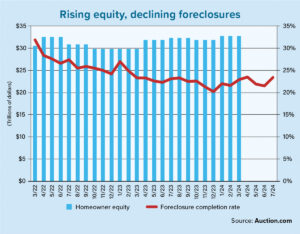Buybacks have been a hot-button topic this year. These transactions, which can happen for up to three years after a loan has closed, involve the institution that bought the mortgage walking back their purchase due to discrepancies or fraud found in the loan. The originating lender must then place the loan back on their balance sheet or resell it, often incurring a loss.
The government-sponsored enterprises, Freddie Mac and Fannie Mae, have triggered an increased number of buybacks this year as they process the loans sold during and after the pandemic-initiated purchase and refinance boom. The timing couldn’t be worse, with these extra expenses coming while lenders’ pockets are already thin. Too many repurchases can spell disaster, especially for smaller lenders. But this impact isn’t felt only at the corporate level — these buybacks impact individual originators too.
“When any lender puts credit restrictions onto their business model, it is the least represented borrower that first gets impacted.”
Taylor Stork, president, Community Home Lenders of America
If you’ve noticed increased calls from confused former clients, you’re not alone, says Taylor Stork, a longtime originator and president of the Community Home Lenders of America (CHLA). When a loan is repurchased, it changes hands at least once, if not twice, and usually changes servicers. This triggers a flood of “hello” and “goodbye” letters to the borrower, who is likely to call their mortgage originator for help figuring out where to send payments.
As the originator, you’re unlikely to know what’s going on and will have to dig for information. If you’re a broker, Stork says, it’s likely you won’t be able to get any information at all, since you’re not privy to the transaction and it’s protected by information security rules.
“(Clients) expect me to make sure that they are taken care of all the way through the process,” Stork says. “For originators, it creates a tremendous amount of confusion. It certainly tarnishes the relationship that we have with our customers and with our referral sources.”
There’s an impact on the originator even before the buyback happens, says Brendan McKay, president of advocacy for the Association of Independent Mortgage Experts (AIME). Before a buyback goes through, the loan is audited. This often means requests to the originator for additional documents from the borrower, sometimes months or years after closing.
The GSEs argue that these loans don’t meet their quality standards, with Freddie Mac citing miscalculated income and missing documents as the two leading causes of buybacks. But lenders and mortgage advocacy organizations argue that many are returned to the lender for minor issues on loans that are still performing well. “These are not bad loans,” Stork says. “These are good loans that may have little, tiny technical errors.”
Often, the repurchase request is not even due to error. “A lot of these, as we’ve gone through them, have been [due to] appraisals,” says Scott Olson, CHLA’s executive director. “People had two appraisals. They both are fine and (the GSEs) are claiming, ‘No, we disagree.’ … It’s just a difference in judgment.”
A lender being forced to take back a performing loan may not seem like a dangerous prospect, but lenders often aren’t equipped to hold loans on their balance sheets. This means they must resell the loan after the buyback, and most lenders turn to what McKay terms the “scratch and dent” market to do so. Loans sold this way incur massive losses for the lender. And this puts smaller lenders at higher risk of default since the losses on only a few buybacks can make a huge difference on their balance sheets. “Getting a loan bought back is absolute misery,” McKay says.
These costs averaged 8 basis points per loan in 2020 before rising to 68 bps in 2023, according to McKay. “That cost, if it continues, is getting passed along to the loan officer and the consumer,” he says. “All of us are going to have worse rates. That’s why originators should care about this.”
Stork says the natural response by lenders and originators is to tighten qualification standards in an attempt to bulletproof the loans and prevent them from being bought back. “When any lender puts credit restrictions onto their business model, it is the least represented borrower that first gets impacted,” he says. “Buybacks result in a tightening of the credit box.”
This past October, the Federal Housing Finance Agency (FHFA) tweaked its buyback policy for loans subject to COVID-19 forbearance. It also reported that GSE repurchase requests have passed their peak, with buybacks now trending downward. But there’s still work to be done.
The CHLA has called for the ceasing of all pandemic-era repurchase requests that aren’t tied to fraud, if the borrower is current on their payments. AIME has called for refinement of the buyback policy, as well as increased transparency and consistency around its enforcement. The FHFA said in October that the GSEs must implement a “fair, consistent and predictable process.” The eventual goal is to create less ambiguity in underwriting, which should reduce buybacks in the long term.
Buybacks are important for originators to understand because they’re on the frontlines and are likely to deal with the fallout. These include a tighter credit box, loan audits and more document requests. In the most dire circumstances, lenders could lay off staff or fold.
“They need to understand their responsibility in helping to protect the industry, whether for everyone’s good or their own good,” McKay says. “This type of pain doesn’t exist in a vacuum. It’s going to get shared by everybody.” ●




